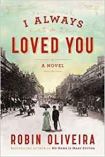Difference between revisions of "I Always Loved You by Robin Oliveira"
(Created page with "{{infobox |title=I Always Loved You |author=Robin Oliveira |reviewer=Rebecca Foster |genre=Historical Fiction |rating=4 |buy=Maybe |borrow=Yes |isbn=9780670017195 |pages=352 |...") |
|||
| (One intermediate revision by the same user not shown) | |||
| Line 1: | Line 1: | ||
| − | {{ | + | {{infobox1 |
|title=I Always Loved You | |title=I Always Loved You | ||
|author=Robin Oliveira | |author=Robin Oliveira | ||
| Line 11: | Line 11: | ||
|publisher=Viking Press USA | |publisher=Viking Press USA | ||
|date=February 2014 | |date=February 2014 | ||
| − | |||
| − | |||
|website=http://www.robinoliveira.com/ | |website=http://www.robinoliveira.com/ | ||
| − | |||
|summary=The complicated relationship between Edgar Degas and Mary Cassatt forms the basis for this well-researched novel's vivid illumination of Impressionist-era Paris. | |summary=The complicated relationship between Edgar Degas and Mary Cassatt forms the basis for this well-researched novel's vivid illumination of Impressionist-era Paris. | ||
| + | |cover=0670017191 | ||
| + | |aznuk=0670017191 | ||
| + | |aznus=0670017191 | ||
}} | }} | ||
Mary Cassatt was an anomaly among the Impressionists: she was one of very few women, and also the only American-born member. A Philadelphia native, she made Paris home for nearly five decades. Oliveira's novel opens in 1926, with Cassatt (now nearly blind) searching for the letters Edgar Degas wrote her in the 1870s-80s. Degas and Cassatt had been subjects of Parisian gossip; no one knew for sure whether their friendship shaded into romance. Even Mary herself seems confused about what they meant to each other; 'she still didn't understand…whether there was room for love in two lives already consumed by passion of another sort. | Mary Cassatt was an anomaly among the Impressionists: she was one of very few women, and also the only American-born member. A Philadelphia native, she made Paris home for nearly five decades. Oliveira's novel opens in 1926, with Cassatt (now nearly blind) searching for the letters Edgar Degas wrote her in the 1870s-80s. Degas and Cassatt had been subjects of Parisian gossip; no one knew for sure whether their friendship shaded into romance. Even Mary herself seems confused about what they meant to each other; 'she still didn't understand…whether there was room for love in two lives already consumed by passion of another sort. | ||
| Line 34: | Line 34: | ||
{{amazontext|amazon=0670017191}} | {{amazontext|amazon=0670017191}} | ||
| + | {{amazonUStext|amazon=0670017191}} | ||
| + | |||
{{commenthead}} | {{commenthead}} | ||
Latest revision as of 12:15, 21 March 2018
| I Always Loved You by Robin Oliveira | |
|
| |
| Category: Historical Fiction | |
| Reviewer: Rebecca Foster | |
| Summary: The complicated relationship between Edgar Degas and Mary Cassatt forms the basis for this well-researched novel's vivid illumination of Impressionist-era Paris. | |
| Buy? Maybe | Borrow? Yes |
| Pages: 352 | Date: February 2014 |
| Publisher: Viking Press USA | |
| External links: Author's website | |
| ISBN: 9780670017195 | |
|
| |
Mary Cassatt was an anomaly among the Impressionists: she was one of very few women, and also the only American-born member. A Philadelphia native, she made Paris home for nearly five decades. Oliveira's novel opens in 1926, with Cassatt (now nearly blind) searching for the letters Edgar Degas wrote her in the 1870s-80s. Degas and Cassatt had been subjects of Parisian gossip; no one knew for sure whether their friendship shaded into romance. Even Mary herself seems confused about what they meant to each other; 'she still didn't understand…whether there was room for love in two lives already consumed by passion of another sort.
The novel's main section spans the years 1877-1883, beginning with Mary as a 33-year-old trainee painter in Paris. She impresses many of the city's up-and-coming artists, including Degas, and earns an invitation to her first Parisian soirée at the Manet home. All the big names of art and literature are there, including Pissarro, Caillebotte and Zola. Oliveira brilliantly recreates the opinionated banter of this group of intellectuals. Setting aside her dreadful accent, the French bohemians find Mary charming and accept her into their circle. 'The fools gave up food to buy paint', she thinks, yet she is delighted to join in their poverty if she can also share their talent and underground success.
Oliveira uses vibrant colours in her descriptions, and populates her novel with many lifelike secondary characters, including Mary's parents and sickly sister Lydia, who come to join her in Paris in 1877 and posed for many of her portraits. Chief among the background characters is Berthe Morisot, a painter in her own right, who was also Édouard Manet's lover – but married his brother Eugène to avoid scandal. Occasional chapters from Berthe's perspective give insight into her troubled conscience – so much so that at times she seems to take Mary's place as central character. The novel's (somewhat twee) title is thus equally applicable to Berthe and Édouard, as well as to Degas and Mary.
Degas and Mary's mercurial relationship mirrors the shifting fortunes of Impressionism. The Impressionists finally mount a profitable exhibit, and Edgar and Mary share a kiss. But then Mary's first solo show receives mixed reviews; their long collaboration on a journal with plates, Le Jour et la Nuit, comes to naught when Degas calls off the publication; and their responses to the Dreyfus Affair reveal that they are on opposite sides of the political spectrum. 'Like a waxing and waning moon, [Degas] came in and out of her life, full of affection and respect one moment, spouting trouble and discord the next.'
Both Edgar and Mary also suffer from crippling self-doubt. He admits to her, 'I have nothing of talent. I have only desire and dogged work. I doubt myself every moment.' Likewise, Mary's inner critic 'harped alternately that she was posing, or that her work was hackneyed and flat, or that she lacked the soul of an artist and was therefore incapable of imparting truth.' In the novel's most arresting sequence, Oliveira comes close to first-person revelation of her two main characters' states of mind in a pair of almost stream-of-consciousness chapters: 'Edgar: What he does not tell her' and 'Mary: What she does not tell him'. It is reassuring to explore the doubts and insecurities of some of history's most celebrated creators.
Even if their romance was destined to fizzle out, even if – contradicting the novel's title – Degas once asked, 'I never loved you, did I?', he undeniably gave Mary the encouragement she needed to succeed as an artist. 'You want the world to admire you, which means you think too much of it,' he once advised her; 'Paint what is real…You must always paint love. You must never paint anything else.' And indeed, Cassatt's most famous portraits feature mothers and children, tender scenes that belie this never-married, childless woman's experience of domestic happiness. Oliveira has written a multi-faceted account of love and its loss – 'For what was lost love? It was the story of everyone's life. [Mary's], Edgar's, Berthe's, Édouard's' – rich with contrasting imagery of colour versus blindness and youth versus age.
Earlier this week I was at the National Gallery in Washington, D.C., where I saw many of the Impressionist works featured in the novel. I had never noticed the museum's sole Berthe Morisot painting before, nor paid much heed to Degas's wax sculpture of a ballet dancer, a piece which receives much attention in the novel (it was modelled after a 14-year-old opera house dancer – with whom Degas might also have slept). I felt that Oliveira had brought these works to life for me – that even if I still have some uncertainty about the details of Cassatt's private life, 'Her work, like [Degas's], was all the legacy she cared to bequeath to the world.'
Further reading suggestion: Read more about these historical characters in The Private Lives of the Impressionists by Sue Roe.
Please share on: ![]() Facebook,
Facebook, ![]() Twitter and
Twitter and
![]() Instagram
Instagram
![]() You can read more book reviews or buy I Always Loved You by Robin Oliveira at Amazon.co.uk Amazon currently charges £2.99 for standard delivery for orders under £20, over which delivery is free.
You can read more book reviews or buy I Always Loved You by Robin Oliveira at Amazon.co.uk Amazon currently charges £2.99 for standard delivery for orders under £20, over which delivery is free.
![]() You can read more book reviews or buy I Always Loved You by Robin Oliveira at Amazon.com.
You can read more book reviews or buy I Always Loved You by Robin Oliveira at Amazon.com.
Comments
Like to comment on this review?
Just send us an email and we'll put the best up on the site.


